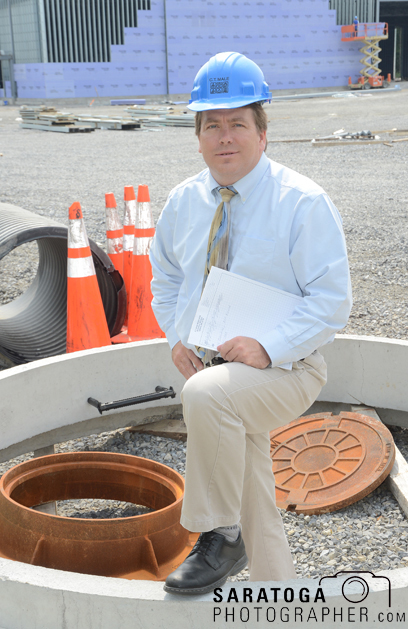
©2016 Saratoga Photographer.com
By Susan E. Campbell
Every building site, redevelopment and manufacturing company faces a complex set of regulatory requirements at the federal, state and local levels designed to protect the environment. Even the public sector and green spaces like trails, parks and cemeteries must comply.
This is the challenge of environmental engineering and consulting, a highly specialized, professional field that is thriving here in Saratoga County. Companies like C.T. Male Associates and The LA Group navigate the ever changing regulatory process by seeking permits, performing research and testing, and resolving when and how a project should best proceed so that the strict standards of the regulators may be met.
“Avoid, minimize and mitigate” is the mantra at The LA Group, said Kevin Franke, director of environmental services. Â
The LA Group serves a wide range of clients but specializes in open spaces. The firm designed the National Cemetery in Stillwater, jump-starting a relationship with the Veterans Administration and ongoing projects both statewide and nationwide.
The avoid-minimize-mitigate process flows this way: A building site has been identified by the Army Corp of Engineers as having wetlands. Priority one is to avoid building on the affected acreage if possible. Otherwise, minimize any environmental risk by reconfiguring the site plan or adjusting the building design.Â
As a last resort, mitigate through the creation of additional wetlands on what was dry land, said Franke.Â
A permit is needed to fill the wetlands and raise the land to a level where the acreage can be developed, he said. The LA Group has a permitting services staff in-house who can work concurrently with the company’s designers and engineers on mitigation challenges, Franke said.
“This strengthens our position as each project is reviewed under the Environmental Protection Policy Act,” he said, which goal is the protection of human health and the surroundings that sustain animal and plant life.
The federal EPA sets a floor of standards that each state must meet and the professionals have learned to navigate.
“Advanced technology and science have provided both the regulators and the community a higher standard than 10 or 20 years ago,” said Dan Reilly, division manager of environmental services for C.T. Male Associates based in Latham.
“New York is not more onerous than other states as to compliance but it is different,” Reilly said. “This is where specialty comes in, in order to really advise the client on a professional level like a CPA or attorney and become part of their team.”
C.T. Male specializes in brownfield redevelopment, such as abandoned parcels or properties that have been idle on the tax rolls for some time, as opposed to as yet undeveloped, or greenfield, real estate.
“We prefer to be part of the overall clean-up or remediation of properties to put them back into productive use,” Reilly said. “Brownfield development is very good for the community, the tax coffers, the developer and the environment.”
C.T. Male is working now with the town of Fort Edward and an interested developer in helping turn a former manufacturing facility into a grocery store, he said.Â
Environmental compliance is not necessarily a one-time thing that, once attained, need not be maintained. Industrial compliance is ongoing, constantly changing, and requiring periodic reporting and inspections anywhere from once a day to once a year.Â
“We can look over the clients shoulder to help them feel confident that they are doing the reporting right,” Reilly said. “Or we can be much more active and manage the environmental compliance program for them.”
Two compliance hot buttons in recent years are stormwater management and endangered species.
The regulators enforce mandates as to the quality and quantity of water that leaves the development site during and after construction. The project has to include measures so that storm water does not leave the site faster than it had pre-construction and that contaminant levels have been addressed, Franke said.Â
The LA Group has designed stormwater capture systems for such clients as the developers of Malta’s technology park and has sought wetlands permits for community leaders like Skidmore College, Stewart’s Shops and Saratoga Hospital.
“It takes years of experience to learn how to be efficient with the permitting process,” said Franke.
Reilly said that advancements in technology make it possible to better understand the scope of contaminants in water and soil through improved tools to identify them.Â
“We can make better real-time decisions today that 20 years ago,” he said. “But as science and technology advance, the bar of environmental protection standards is also raised.”
He said a good example is water quality.Â
“There is a high level of demand for higher quality potable water today,” said Reilly. “While we can detect more contaminants today than decades ago, we also have to put the readings into perspective for the lay person so that they are not alarmed.”Â
In other words, looking for contaminants that have been there in the water for decades will surely be identified. But that doesn’t necessarily mean an increased health risk.
“We believe that in the long run it is better for the public to understand,” Reilly said, “and we have a professional obligation to maintain perspective.”
The endangered species list is in constant flux as some creatures are removed from the list and others are added. Here in Saratoga County the Blue Karner Butterfly remains protected. If blue lupines grow at the site, the regulations are clear. At other times the agencies have not so narrowly defined what is good and not good remediation when certain species such as bats are present.
“There is always a concern over any area where there are trees,” said Franke. “The safest course is to clear trees during the winter months” when many species have hibernated, migrated, or are not nesting.
“Overall, it is important to utilize environmental consultants who can help navigate a complex process and help reach client goals,” Reilly said.
“Better to involve your consultant up front so that they can guide the entire process,” he said.
